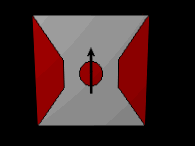
Materials Research Science and Engineering Center: Faculty Publications
Document Type
Article
Date of this Version
7-1-2004
Abstract
Permanent magnets with the general composition Pr9 (Fe0.95Co0.05)85.5M0.5B5, where M denotes a transition metal, have been produced by melt spinning. The effect on the microstructure and magnetic properties of eight different alloying elements has been examined. The grain size and distribution have been correlated to the maximum energy product obtained. The grain size of the Pr9 (Fe0.95Co0.05) 85.5B5 control alloy was determined to be 17.5 nm, and it was found that the grain size was not significantly reduced compared to the control alloy by any of the additions. However, some additions resulted in significant increases in grain size, notably Cu, Ti, and Cr, which had grain sizes between 26 and 36 nm, and an increase in the grain size distribution. The increase in grain size resulted in a loss in hysteretic squareness, leading to reduced energy products in these alloys. In other alloys, fine grain size did not always correlate to improved maximum energy products. For example, the Mo-added alloy had the finest grain size but a decreased maximum energy product, likely due to solute segregation to grain boundaries that inhibited intergranular exchange interactions. In general, Group VB additions had a more positive effect on the microstructure and magnetic properties than did other alloying additions. This paper will summarize the overall effects of the additions on the microstructures and magnetic properties, enabling further alloy design efforts in nanocomposite alloy systems.


Comments
Published in IEEE TRANSACTIONS ON MAGNETICS, VOL. 40, NO. 4, JULY 2004. Digital Object Identifier 10.1109/TMAG.2004.832110 Used by permission. http://www.ieee.org/portal/pages/pubs/transactions/tm.html
"©2004 IEEE. Personal use of this material is permitted. However, permission to reprint/republish this material for advertising or promotional purposes or for creating new collective works for resale or redistribution to servers or lists, or to reuse any copyrighted component of this work in other works must be obtained from the IEEE."